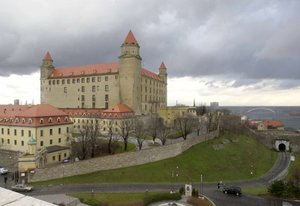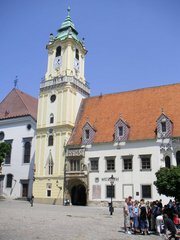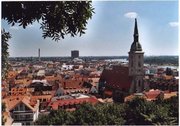Bratislava
|
|
Bratislava is the capital of Slovakia and the country's largest city, with a population of some 430,000. Bratislava lies on the River Danube, at Slovakia's borders with Austria and Hungary, and relatively close to the border with the Czech Republic. It is only 60 km (45-65 minutes by train) from Vienna. The city is the most densely populated in Central Europe. The Carpathian mountain range begins within the territory of the city with the Malé Karpaty (or Little Carpathians) mountains (part of the Carpathians).
Bratislava is the seat of the Slovak presidency, parliament and government. The city is home to universities, a relatively large number of museums, and to theatres and other cultural institutions (for example, the famous Slovak Philharmonic Orchestra).
Historically, the town has been influenced by several nations (among others, Austria, Hungary, and Slovakia). As is common for former cities of Austria-Hungary, Bratislava had other names, out of which the following ones were the only used or official forms before the end World War I (1919) :
- Pressburg, the German name (today still the official alternative German name)
- Pozsony, its name in Hungarian (today still the official alternative Hungarian name)
- Prešporok, its old Slovak name
| Contents [hide] |
Basic data
Location: on both banks of the Danube, at the foot of and in the Little Carpathians, directly at the Austrian and Hungarian borders

Climate: mild; annual mean temperature: 9.9 °C, annual hours of sunshine 1976.4, average annual rainfall 527.4 mm (1993)
History
See also: History of Bratislava (includes the development of the ethnic structure and important personalities)
- Neolithic Age: the first permanent settlement of the region now known as Bratislava begins with the Linear Ceramics Culture
- 400-50 B. C.: Celts were settled here. From 125 B. C. on they had an important celtic oppidum (fortified town) with a mint here.
- 1st century – 5th century: the border of the Roman Empire (Limes Romanus) runs right through the middle of today's town; many Roman (e.g. "Gerulata") and Germanic settlements
- 6th century-8th century: first Slavs (500 A.D.- today) and Avarians (560s - 8th century)
- late 8th century – 833: part of the Nitrian principality (Principality of Nitra)

- 1536-1784: capital of the Kingdom of Hungary (whose territory consisted until 1699 of today's Slovakia and parts of today's Western Hungary, because the Turks ruled Buda at that time); the Kingdom of Hungary was part of the Habsburg (i. e. Austrian) Monarchy from 1526 to 1918
- 1542-1848: meeting place of the Hungarian Diet (with short interruptions)
- 1563-1830: coronation town for Hungarian kings (St. Martin's Cathedral (see the picture))
- since the 18th century: a center of the Slovak national movement
- 1919-1939: part of Czechoslovakia; official new name becomes "Bratislava"- instead of "Prešporok" (Slovak) /"Pressburg" (German)/ "Pozsony" (Hungarian) in 1919
Ba-primatialpalast.jpeg
- 1969-1992: the capital of the Federal State of Slovakia within Czechoslovakia
Names of the city
The main known names of the town were as follows:
- 805/7 (maybe): Wratisslaburgium, Pisonium (Latin)
- late 9th century(?): Braslava (?)(assumed medieval Slavic form, probably after a Slav prince Braslav)
- around 850 : Istropolis (Greek, stems from the christianisation period, has been later used by king Matthias Corvinus)
- 907: Brezalauspurc(h) (the first sure name; found in the Salzburg Annals; according to some sources derived from Braslava—see above; according to newer sources: derived from the name Predslav, the 3rd son of Svätopluk - see also after 1001; note that "P" and "B" are very often interchanged in Austrian and Bavarian local and family names as Bavarian accent does not differentiate between them) Missing image
Ba-michaelertor.jpeg - after 1001: Preslav(v)a Civitas (Latin) (this name has been found only recently on coins)
- 1002: Poson (Hungarian form, probably after the 9th century Slav prince Božan)
- 1042: Brezesburg
- 1045: Bosenburg
- 1048: Brecesburg
- 1052: Poson, Brezisburg, Bresburc, Preslawaspurch
- 1098: Prespurch
- 1107: Bosan
- 1108: Preburch, Bosania, Prespurch, Bresbruch, Prespuerch, Brespurg, Posonia, Possen
- 1109: Bosan, Presburch
- 1142: PosonMissing image
Bratislava-Dom-sv-Martina.jpgSt. Martin's Cathedral - the coronation cathedral - 1143: Bosonium
- 1146: Bosan
- 1147: Prespurch
- 1151 and 1163/4: Posonium (Latin, origin like Poson above)
- 1172 and 1194: Poson
- 1189: Bosonium, Brezburc, Bosonium quod Prespurc teutonice nuncupatur, Brisburc, Posonium
- 1197: Posony
- 1217: Posonia
- ...
- later also:
- - German: Pressburg, Preßburg
- - Greek: Istropolis (meaning "the Danube City")
- - Latin: Posonium
- - Hungarian: Pozsony
- - Slovak: Pressporek (1773), Prešporok (later) – stems from the German form
- - Czech: Prešpurk
- - French: Pressbourg, later: Presbourg – see e. g. the corresponding street name in Paris : rue de Presbourg
- - English: Pressburg(h), Pressborough; e.g. there is a Pressburg street in the south west of Greater London
- 1918 temporarily: Wilsonovo mesto (i. e. "Wilson City", after US-president Woodrow Wilson)
- since 1919: Bratislava (official name, origin disputed:according to older sources it is a mutilation of the old Slavic form Braslava, other say it is an invention by the US-president Wilson, according to newer sources it was created in the early 19th century by members of the Slovak movement and is derived (by mistake) from the name of the Bohemian ruler Bretislav)
Sights
Bratislava is picturesquely situated on both banks of the Danube, at the base of the outlying spurs of the Little Carpathians, in a position of strategic importance near the Devín Gate (earlier called Hainburger Pforte or Porta Hungarica), and the area includes a picturesque old town.
One of the most conspicuous buildings of the town is the Bratislava Castle situated on a plateau 270 ft. above the Danube. The castle exists since time immemorial, has been the acropolis of a Celtic town, a part of the Roman Limes Romanus, a huge Slav fortified settlement and a political, military and religious center of Great Moravia. A castle of stone was built only in the 10th century (part of Hungary), it was turned to a Gothic anti-Hussite fortress under Sigismund of Luxemburg in 1430, in 1562 to a Renaissance castle, and in 1649 a baroque reconstruction took place. Under queen Maria Theresa, the castle was turned into a prestige seat of the royal governor Albert von Sachsen-Teschen, the son-in-law of Maria Theresa, who founded the Albertina picture gallery in the castle, which was later moved to Vienna. In 1784, when Bratislava ceased to be the capital of Hungary, the castle was turned to a school for Catholic clergy, and later in 1802 to barracks. In 1811, the castle was inadvertently destroyed by fire by the soldiers of the barracks and was in ruins till the 1950s, when it was reconstructed mostly in its former Maria Theresa style.
Ba-haus_zum_guten_hirten.jpeg
Another castle is the Devín Castle (still in ruins) in the city part Bratislava-Devín. It is situated on the top of a high rock at the point where the March (Morava) river, which forms the boundary between Austria and Slovakia, falls into the Danube. It is one of the most important Slovak archaeological sites and has been –thanks to its excellent location –a very important frontier castle of Great Moravia and the early Hungarian state. It was deliberately destroyed by Napoleon troops in 1809 and is an important symbol of Slovak and Slavic history.
Yet another castle, built in 1813 and turned to English Gothic style castle in the late 19th century, is situated in the city part Bratislava-Rusovce, otherwise known for ruins of Roman Gerulata settlements.
Other noteworthy buildings are:
- the St. Martin's Cathedral (a Gothic edifice of the 14th-15th century replacing an older church from the 13th century) in which many of the Hungarian kings were crowned
- Bratislava's Town hall (a complex of 14th-15th century buildings) containing an interesting museum – the City Museum founded in 1868
- Bratislava's Franciscan church, dating from 1297
- the building of the University Library (erected in 1756) where the sittings of the Diet (parliament) of the Kingdom of Hungary were held from 1802 to 1848
- the Primate´s Palace (erected in 1781) in which the (4th) Peace of Pressburg has been signed
- the beautiful Slovak National Theatre (built in 1886), and
- the Michael's Gate (early 17th century), the only still existing tower of the town wall
- the narrowest house in central (or maybe in whole) Europe (just behind the Michael's Gate)
- Nový Most Bratislava is a bridge across the Danube river, featuring a UFO-like tower restaurant
- Kamzik TV Tower is a TV tower of unique design with an observation deck
Ba-nationalgalerie.jpeg
In general, the historic center is characterized by many baroque palaces. The Grassalkovich palace (built around 1760), for example, is now the residence of the Slovak president, and the former Archiepiscopal palace (1614-1765, the former summer residence of the archbishop of Esztergom) is now the seat of the Slovak government.
Economy
The economy of Bratislava is based mainly on services, engineering (Volkswagen) and electrical industry; there is also an important international road and railroad junction, Milan Rastislav Štefánik international airport, and a river port. The GDP per capita (PPP) reaches 119% of the EU average, which is the second highest level (behind Prague) of all regions in all recent and expected aceeding countries (Eurostat, data as of 2002; for data of 2000 see for example: [1] (http://www.eu-datashop.de/download/EN/sta_kurz/thema1/dn_03_02.pdf))
Ba-palais_grassalkovich_front.jpeg
Territorial division
- 5 districts (for the purpose of national administrative division):
- Bratislava I (covers the city)
- Bratislava II (covers the east and southeast)
- Bratislava III (covers the north and northeast)
- Bratislava IV (covers the west)
- Bratislava V (covers the right river bank, i.e. the south, esp. the largest city part Petržalka)
- 17 "city parts" (for the purpose of municipal administrative division and of serving as entities to which the town delegates its powers and functions imposed by law on communities), the number in brackets shows the corresponding district:
- 1 Staré Mesto (I) ["Old Town"]
- 2 Ružinov (II)
- 3 Vrakuňa (II)
- 4 Podunajské Biskupice (II)
- 5 Nové Mesto (III) ["New Town"]
- 6 Rača (III)
- 7 Vajnory (III)
- 8 Karlova Ves (IV)
- 9 Dúbravka (IV)
- 10 Lamač (IV)
- 11 Devín (IV)
- 12 Devínska Nová Ves (IV)
- 13 Záhorská Bystrica (IV)
- 14 Petržalka (V)
- 15 Jarovce (V)
- 16 Rusovce (V)
- 17 Čunovo (V)
- 20 "cadastral areas" (townships): they are identical with the above city parts, except that:
- Nové Mesto is split in Nové Mesto + Vinohrady, and
- Ružinov is split into Ružinov + Nivy + Trnávka
Population
Bratislava has 428 672 inhabitants with an average age of 38.7 y [2001 census], out of which:
- in Districts: Bratislava I 44 798, Bratislava II 108 139, Bratislava III 61 418, Bratislava IV 93 058, Bratislava V 121 259
- Nationality: Slovaks 391 761, Hungarians 16 451, Roma 417, Czechs 7 972, Moravians 635, Ruthenes 461, Ukrainians 452, Germans 1 200, Poles 339, Croats 614
- Religion: Roman Catholics 243 048, Lutherans of Augsburg Confession 24 810, Greeks Catholics 3 163, Reformed Christians 1 918, Orthodox 1 616, Jehovah's Witnesses 1 827, Methodist Protestants 737, Jews 700, Baptists 613
- Age: 0 – 5 : 4.1 %, 6 – 14: 9.8 %, Productive Age: 62.9 %, Post-productive Age: 19%
External links
- Bratislava travel guide at Wikitravel (http://wikitravel.org/en/article/Bratislava)
- Official website (http://www.bratislava.sk)
- Bratislava information, history, tips (http://www.bratislavacity.sk/en/)
- Official Bratislava Tourist Service (http://www.bkis.bratislava.sk/e_index.asp)
- Bratislava Tourist Service (http://www.bratislava-info.sk/index.php?language=english&)
- Bratislava, Slovakia - city districts (http://www.bratislavaslovakia.com/)
- Bratislava, Slovakia news (http://www.bratislava-city.sk/)
- Bratislava tourist guide (http://www.bratislavaguide.com)
- Public urban transport in Bratislava (http://www.imhd.sk/ba/?lang=en)
- Bratislava photo gallery (http://www.angelfire.com/home/vj/bratislava/Downtown.htm)bg:Братислава
bs:Bratislava ca:Bratislava cs:Bratislava de:Bratislava et:Bratislava es:Bratislava eo:Bratislavo fr:Bratislava id:Bratislava it:Bratislava he:ברטיסלאבה la:Bratislava lt:Bratislava hu:Pozsony nl:Bratislava nds:Preßburg ja:ブラチスラヴァ no:Bratislava pl:Bratysława pt:Bratislava ro:Bratislava ru:Братислава simple:Bratislava sk:Bratislava sl:Bratislava sr:Братислава fi:Bratislava sv:Bratislava zh:布拉迪斯拉发



